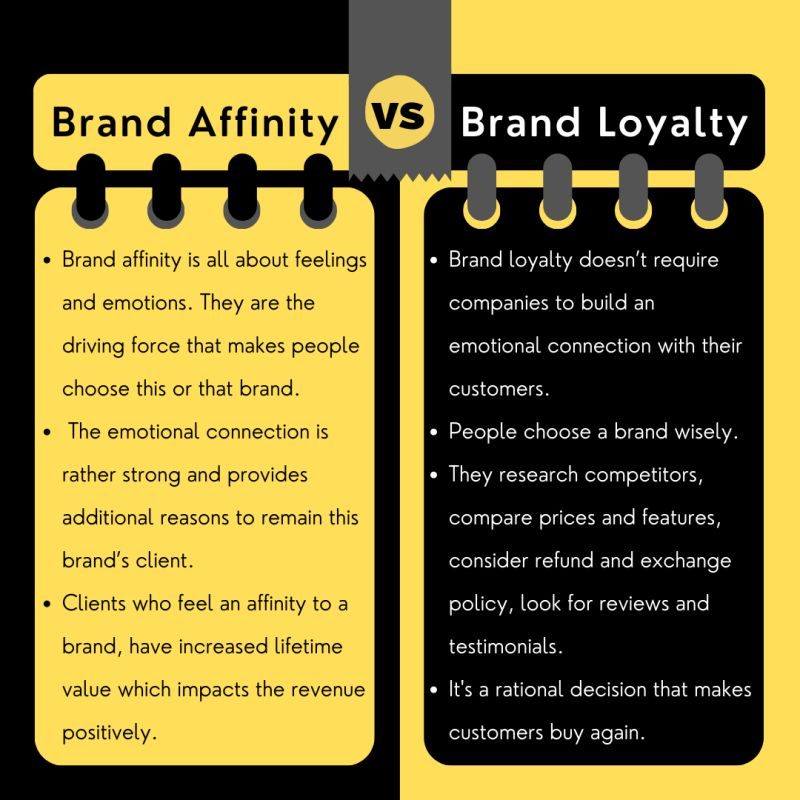Brand affinity involves fostering an emotional bond between a brand and its customers. Individuals who resonate with a brand’s values are more inclined to select its products and advocate for them among their peers.
What is brand affinity?
Brand affinity is a testament to consumers genuinely caring about your brand. They internalize your company’s values and establish a natural, trusting relationship with you.
Brand affinity epitomizes the emotional rapport forged between customers and companies. Individuals who resonate with a brand’s values gravitate toward its products and enthusiastically endorse them to others.
This deep-seated connection profoundly influences every step of the purchasing journey. The transition from brand awareness to genuine appreciation marks a pivotal moment where affinity takes root. This affinity blossoms through various avenues, including interactive engagements with the audience.

Why is brand affinity important?
Brand affinity is a cornerstone among vital marketing metrics, brand preference, and loyalty. It empowers companies to forge emotional connections with their clientele, adding an invaluable layer to their endeavors.
When clients find a brand that mirrors their beliefs, they experience a sense of support, harmony, and gratitude. Consequently, these sentiments become intertwined with the brand itself. Given the undeniable influence of emotions on human behavior, customers naturally gravitate towards brands that evoke positive feelings, considering them the optimal choice.
This alignment translates into heightened sales figures. Moreover, clients who harbor a strong affinity towards your brand tend to exhibit increased lifetime value, positively impacting your revenue stream.
Before delving into techniques for nurturing brand affinity, it’s crucial to discern the distinction between brand affinity and loyalty, as these terms are often erroneously conflated.
Brand Affinity vs Brand Loyalty
These terms diverge primarily in the motivating factors that drive consumers to choose one brand over another.
| Brand affinity | Brand loyalty | |
| Definition | Linked to emotions and sentiments | Predominantly rooted in rational decision-making processes |
| Factor effect Consumers before purchasing | Emotional attachment | Competitors, pricing, product features, return policies, and customer reviews |
| Why Consumers choose a brand | Shared values and emotional resonance. | Trust and satisfaction |

In the subsequent section, we will unveil a selection of proven strategies to foster brand affinity. Stay tuned for actionable insights to elevate your brand’s connection with its audience.
What can you do to increase brand affinity?
A comprehensive approach spanning various business domains is essential to enhance brand affinity. How to build brand affinity? Below are several key strategies:
1. Understand Customer Values
Gain insight into your customers’ core values, needs, preferences, and perceptions. Conduct surveys to gauge their understanding of your brand’s values and whether they align with them. Adjust your strategies accordingly to ensure alignment and resonance.
2. Deliver Exceptional Customer Support
Offer top-notch customer service characterized by 24/7 availability, personalized interactions, and a friendly demeanor. Ensure that your support team embodies the ethos of your brand, treating customers as friends rather than just transactions.
3. Collaborate with Influencers
Partner with influencers who align with your brand’s values to amplify your brand’s reach and attract like-minded customers. Consider working with micro-influencers who may already be customers or enthusiasts of your products, leveraging their credibility and audience trust.
4. Cultivate a Brand Community
Create a sense of belonging among your customers by establishing a brand community where they can connect with like-minded individuals who share common interests and values. Foster trust and nurture long-term relationships within this community.
5. Engage on Social Media
Leverage the power of social media to engage with your audience, gather feedback, and showcase your brand’s values. Utilize social listening tools to monitor brand mentions and sentiment, promptly responding to positive and negative feedback. Encourage interaction, share valuable content, and provide customer support via chatbots to enhance the overall customer experience.
By implementing these strategies, you can strengthen brand affinity and foster deeper connections with your audience.
How do we measure brand affinity?
There isn’t a single definitive method to measure brand affinity, but many metrics exist to gauge your brand’s performance accurately. Monitoring these indicators offers a comprehensive overview of your brand’s standing. Some key metrics include:
- Net Promoter Score (NPS): This measures the percentage of customers who are highly satisfied with your company and willing to recommend it to others. Customer surveys typically assess it on a scale of 1 to 10.
- Customer Lifetime Value: This metric calculates the total revenue expected from a customer throughout your relationship. It reflects customer retention and loyalty efforts.
- Referrals: These are new customers acquired through recommendations from existing clients. Monitoring referral rates provides insights into customer loyalty and the effectiveness of your referral programs.
- “Time Spent” in Google Analytics: Analyzing session duration and page views in Google Analytics helps gauge audience engagement. Longer session times indicate compelling content that resonates with your audience.
- Facebook Insights and YouTube Analytics: These tools offer insights into audience engagement and content performance, including metrics like watch time and engagement rates.
- Brand Search Volume: Utilize Google Search Console to track the volume of searches using your brand name. Higher search volumes indicate growing brand awareness and affinity.
- Social Media Mentions: Monitor mentions of your brand on social media platforms to gauge customer sentiment and identify areas for improvement.
Now equipped with an understanding of why brand affinity matters, its distinction from brand loyalty, and methods to develop and measure it, you can leverage resources like our Facebook Marketing blog to enhance communication with your clients and elevate your brand’s performance.

Related posts: